Welcome to your new favorite weeknight meal: a delectable **Cabbage Curry** that’s as easy to prepare as it is bursting with flavor. In just 15 minutes, you can transform humble cabbage into a vibrant, aromatic dish, complete with tender edamame. Whether you’re seeking a hearty, plant-based main course or a quick and nutritious vegetable side to elevate any meal, this curried cabbage recipe is a true culinary gem, designed for speed, taste, and wholesome goodness.
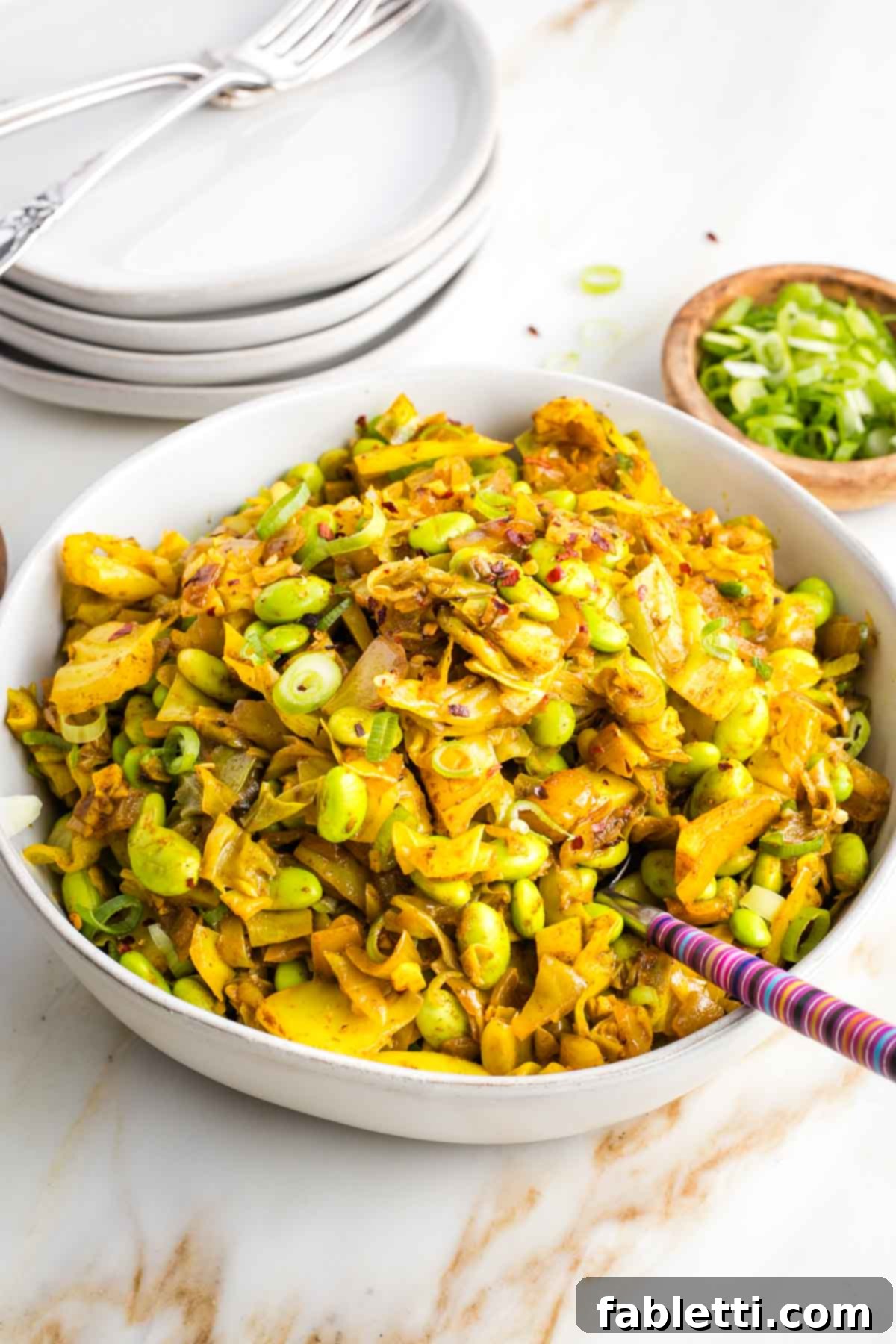
The Undeniable Charm of Cabbage: A Culinary Powerhouse
Cabbage is often underestimated, yet it stands as a truly remarkable and nutrient-dense vegetable. Beyond its affordability and year-round availability, cabbage is a powerhouse of health benefits. It’s packed with fiber, which promotes satiety and aids digestion, making it an excellent choice for those looking for filling yet low-calorie meals. Its mild, slightly sweet flavor profile makes it incredibly versatile, eagerly absorbing the rich, aromatic spices of a well-crafted curry, transforming into a tender, savory delight.
I find joy in the simplicity and practicality of cabbage. It’s an incredibly budget-friendly ingredient that stays fresh in the refrigerator for weeks, a true blessing for meal planning. To maximize its shelf life, store raw cabbage in your crisper drawer, wrapped in a plastic bag with a paper towel to absorb excess moisture.
While I adore experimenting with cabbage in various forms, such as roasted red cabbage or comforting vegan stuffed cabbage rolls, my go-to recipes when time is of the essence are usually a simple, refreshing cabbage salad or, of course, this quick and flavorful curried cabbage dish that comes together in mere minutes.
Choosing the Best Cabbage for Your Curry
The type of cabbage you select can significantly influence the texture and appearance of your curry. Here’s a quick guide to help you choose:
- Green Cabbage: This is my top recommendation for chopping and sautéing in a curry. Its sturdy leaves hold their shape well during cooking, tenderizing beautifully without becoming mushy, and perfectly absorbing the curry spices.
- Savoy or Napa Cabbage: These varieties can work in a pinch, but be aware that they have a higher water content and tend to soften more quickly, potentially resulting in a slightly soggier texture.
- Red Cabbage: Red cabbage will retain its crispness and readily embrace the curry flavors. However, it’s worth noting that the vibrant red pigment can sometimes leach into the dish, creating an unusual, brownish-purple color that some may find less appealing visually.
Why You’ll Fall in Love with This 15-Minute Cabbage Curry
This isn’t just another recipe; it’s a game-changer for busy weeknights and a delightful addition to any meal plan. Here’s why this curried cabbage will quickly become a favorite:
- Incredibly Budget-Friendly: Cabbage is one of the most economical vegetables, allowing you to create a satisfying meal without breaking the bank.
- Lightning Fast & Effortless: From chopping to serving, this dish is ready in just 15 minutes, making it perfect for those hectic days when you need a quick, healthy solution.
- Satisfying & Filling: Packed with fiber from the cabbage and protein from the edamame, this curry will keep you feeling full and content.
- Remarkably Versatile: Enjoy it as a flavorful, light plant-based main meal, or serve it as an invigorating side dish to complement anything from grilled proteins to grains.
- Warm, Comforting, and Flavorful: The blend of savory spices creates a comforting warmth that invigorates the senses, making it ideal for any season.
- Nutrient-Dense & Low in Calories: This dish is a fantastic way to boost your vegetable intake, offering a wealth of vitamins and minerals for minimal calories.
- Vegan and Gluten-Free Friendly: Naturally accommodating various dietary needs, this recipe is a wholesome choice for everyone.
Essential Ingredients & Smart Substitutions
This recipe relies on a handful of accessible ingredients that come together to create a symphony of flavors. Here’s what you’ll need and some flexible alternatives:

- Green Cabbage: As discussed, green cabbage is ideal for its texture and ability to absorb flavors. It’s rich in fiber and water, contributing to the dish’s satisfying nature. Substitution: Bok choy or even shredded Brussels sprouts can be used for a slightly different, yet equally delicious, result.
- Edamame: Keep a bag of shelled edamame in your freezer! It’s an effortless way to introduce plant-based protein, adding a lovely bite and nutritional boost. Substitution: Frozen peas or chickpeas are excellent alternatives, offering similar texture and protein.
- Curry Powder: This spice blend is the heart of the dish. The recipe card details a simple combination of turmeric, cumin, ginger, dried mustard, black pepper, and cinnamon if you don’t have a pre-mixed curry powder in your spice cabinet. Remember that curry powders vary in heat, so adjust to your preference.
- Yellow Onion: Essential for building a flavorful base, adding sweetness and depth.
- Garlic: Freshly minced garlic provides an aromatic punch that is crucial for any good curry.
- Salt & Black Pepper: Basic seasonings to enhance all the flavors.
- Water or Broth: Used to create steam and prevent sticking, while keeping the dish light.
- Scallions: Thinly sliced scallions add a fresh, mild oniony garnish and a pop of color. Substitution: Fresh parsley or cilantro also make wonderful garnishes. Shallots can be used in place of yellow onion for a more delicate flavor.
Step-by-Step: Crafting Your Delicious Cabbage Curry
Creating this flavorful curry is incredibly straightforward. Follow these simple steps for a perfect meal every time:

Step 1: Build the Aromatic Base. In a large, heavy skillet (cast iron works wonderfully), gently sauté the diced onions in a splash of water, olive oil, or vegetable broth over medium heat. Cook them until they begin to soften and become translucent, which usually takes about 2 minutes. Once soft, sprinkle in your curry powder, salt, black pepper, and minced garlic.
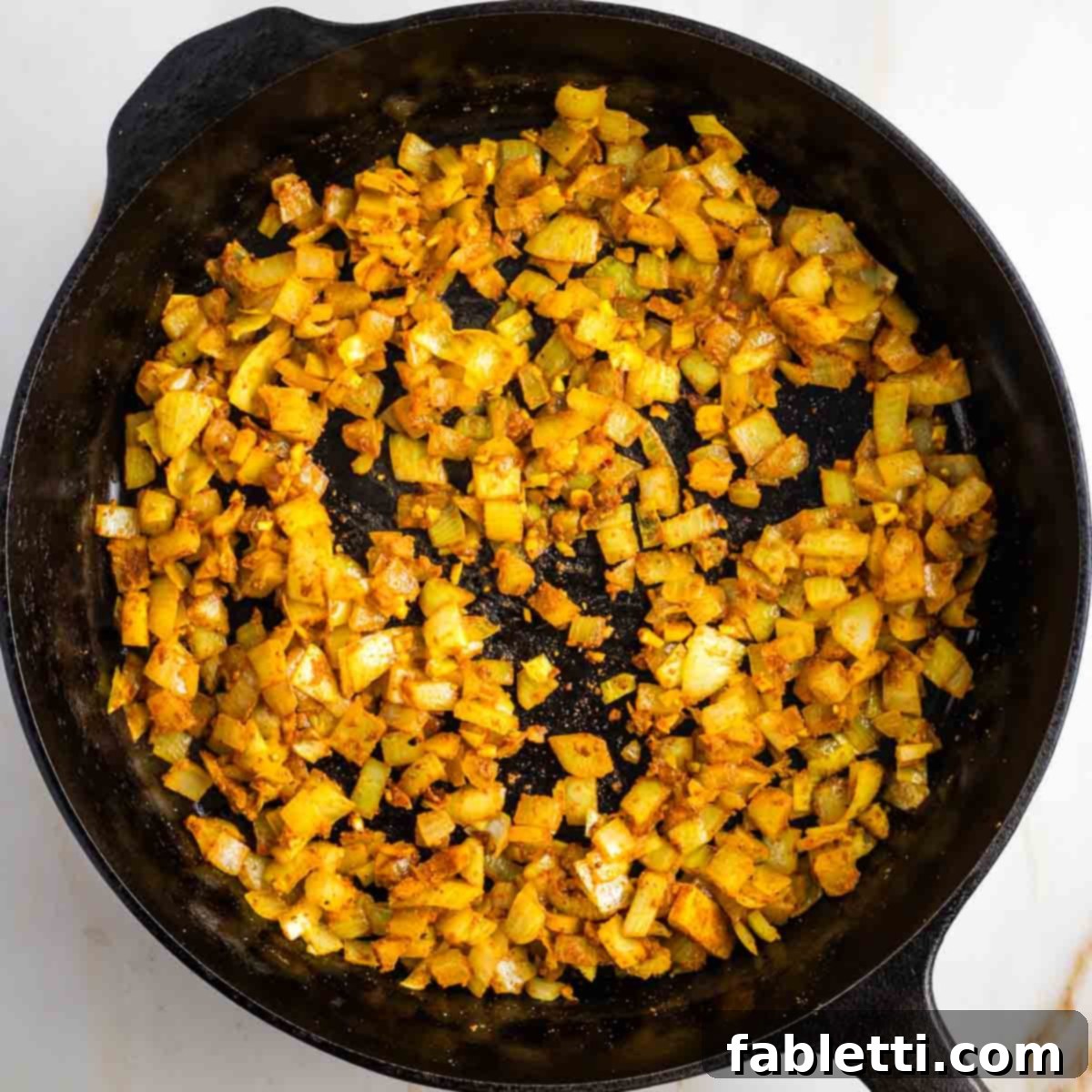
Step 2: Bloom the Spices. Continue to cook the mixture, stirring constantly for approximately 30 seconds. This crucial step “blooms” the spices, releasing their full fragrant potential. If you notice the pan becoming too dry, add 1-2 tablespoons of water to prevent anything from sticking or burning.
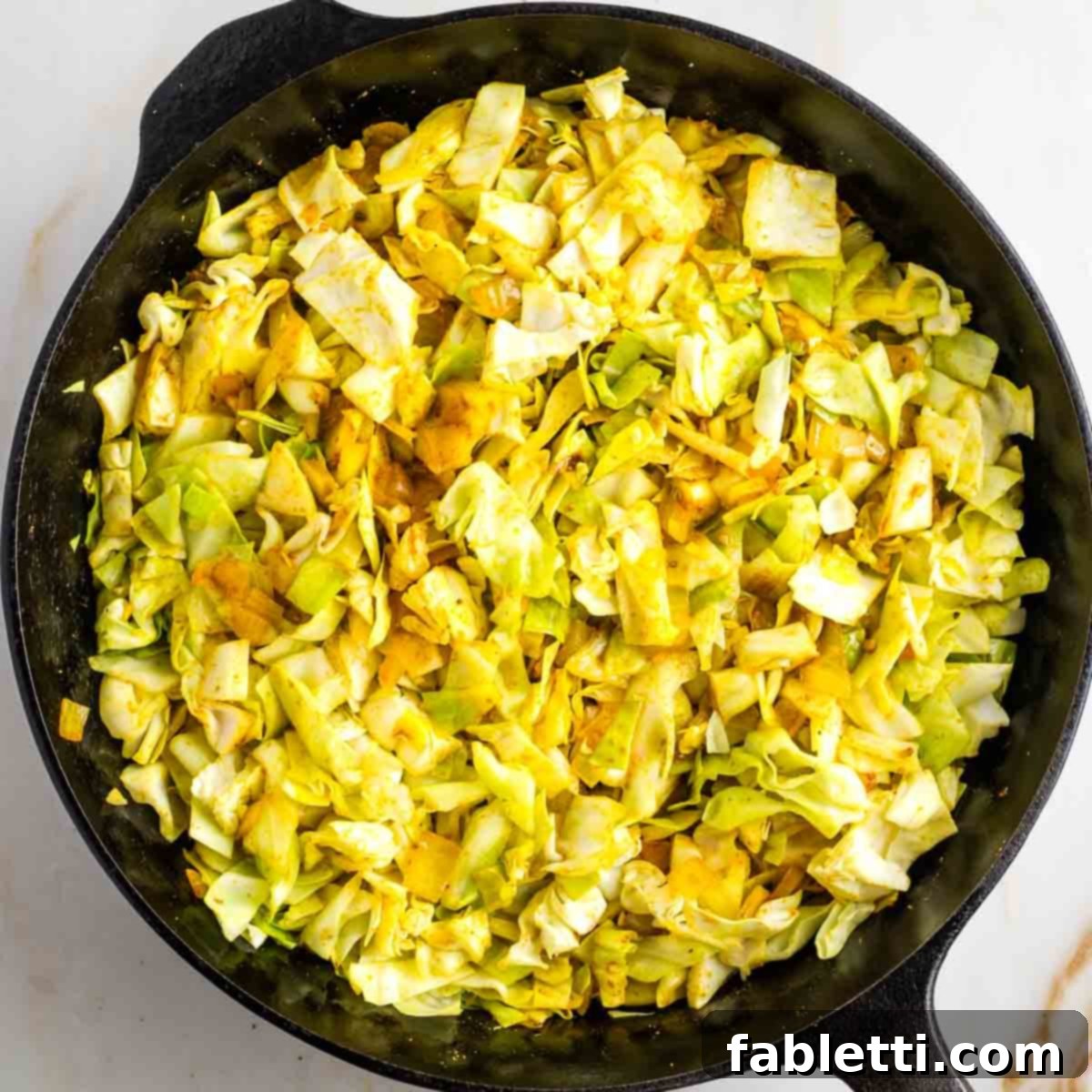
Step 3: Introduce the Cabbage. Add the roughly chopped cabbage to the skillet. Stir it well, ensuring each piece is thoroughly coated with the aromatic spice mixture. Don’t worry if the pan looks crowded at first; the cabbage will dramatically shrink as it cooks down.
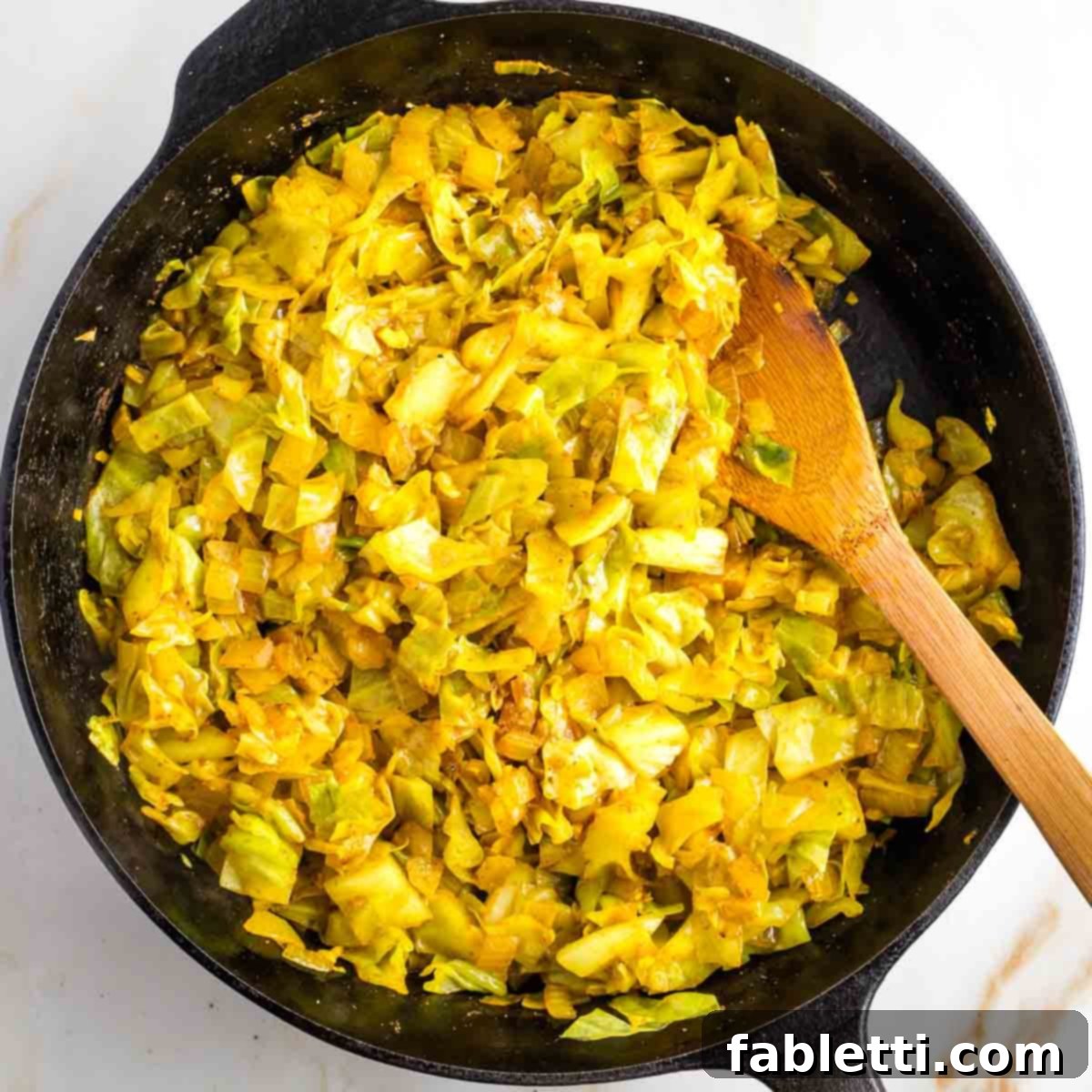
Step 4: Simmer to Tenderness. Pour in ¼ cup of water, give it another stir, then cover the skillet with a lid. Allow the cabbage to simmer and steam for about 5 minutes. This helps the cabbage tenderize beautifully and absorb the deep curry flavors. After 5 minutes, stir again, adding another 1-2 tablespoons of water if the pan seems too dry.
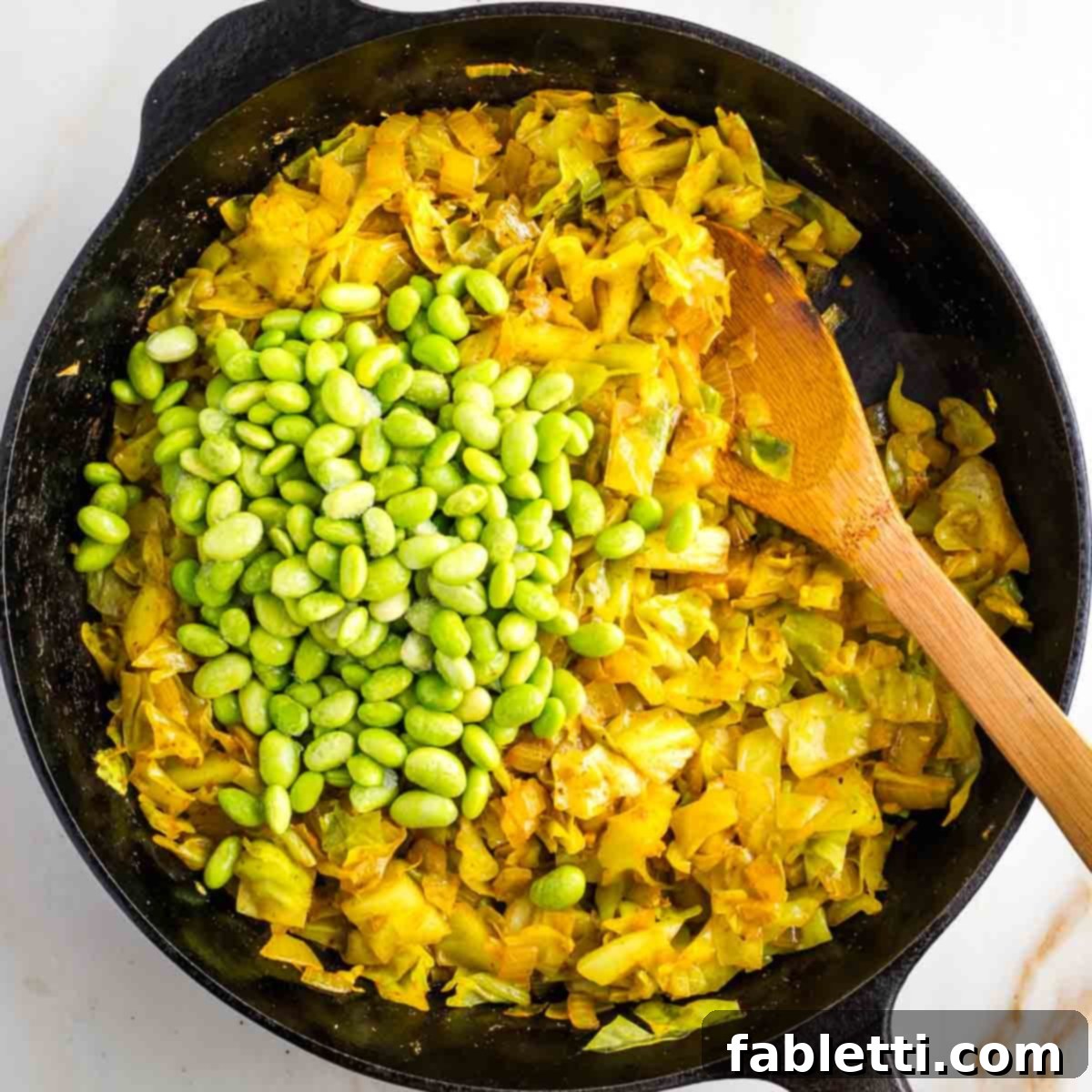
Step 5: Add Edamame. Remove the lid and stir in the frozen shelled edamame beans. Continue cooking for another 2 minutes, stirring occasionally, until the edamame is thoroughly heated through and the cabbage has reached your desired level of tenderness.

Step 6: Garnish and Serve. Taste the curry and adjust seasonings as needed. If you prefer more heat, now is the time to add a pinch of crushed red pepper flakes. Garnish generously with the thinly sliced scallions and serve warm. Enjoy your quick, flavorful, and incredibly satisfying Cabbage Curry!
Debra’s Pro Tips for the Perfect Cabbage Curry
Unlock even more flavor and efficiency with these expert tips:
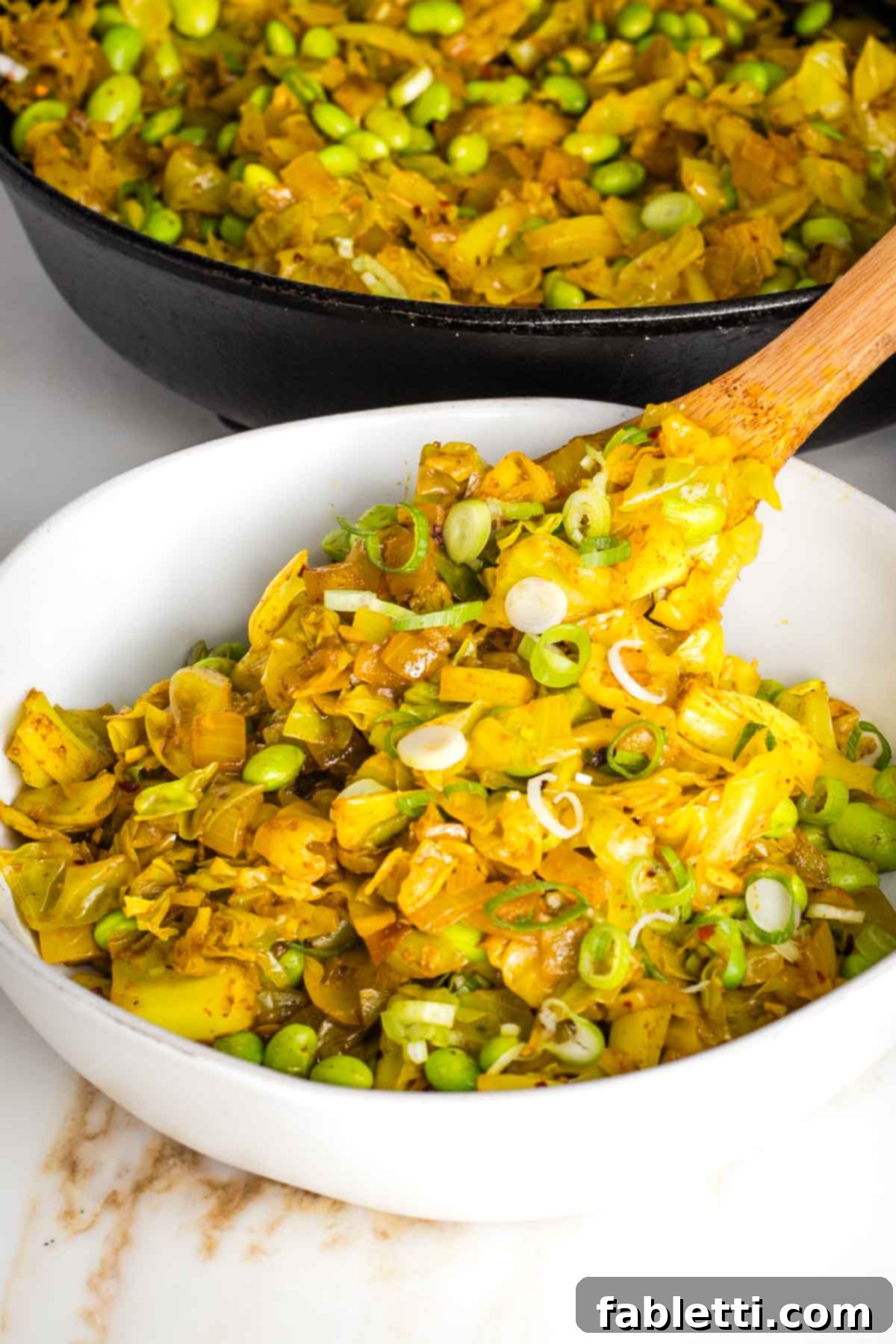
- Prevent Sticking: The key to a non-burnt curry is moisture. Always keep a close eye on your pan and add a tablespoon or two of water or broth if the spices or cabbage start to stick to the bottom. This allows for gentle simmering and caramelization without excess oil.
- Spice Level Awareness: Curry powders vary widely in their heat level. If you know your curry powder is on the spicier side, consider omitting the black pepper in the initial seasoning. If you crave more heat, crushed red pepper flakes make an excellent garnish for individual servings. Always taste and adjust!
- Cool Down the Heat: If your curried cabbage unexpectedly turns out spicier than you intended, serving it alongside a cooling element can work wonders. A dollop of vegan tzatziki, a spoonful of plant-based yogurt, or a side of fluffy rice will help balance the flavors.
- Time-Saving Shortcut: For ultimate convenience, grab a bag of pre-shredded coleslaw mix from your grocery store. It typically contains green cabbage (and sometimes carrots), eliminating the need for chopping. Simply add it to the pan as is!
- Enhance Flavor with Fresh Herbs: A sprinkle of fresh cilantro or parsley just before serving can brighten the entire dish, adding another layer of aromatic complexity.
- Toasted Spices: For an even deeper flavor profile, lightly toast whole cumin and coriander seeds in the dry pan for 30-60 seconds before adding the oil/broth and onions. Grind them afterward or use them whole.
Storage & Creative Serving Ideas
This cabbage curry is just as delightful the next day, making it perfect for meal prep. Here’s how to store it and some inspiring serving suggestions:
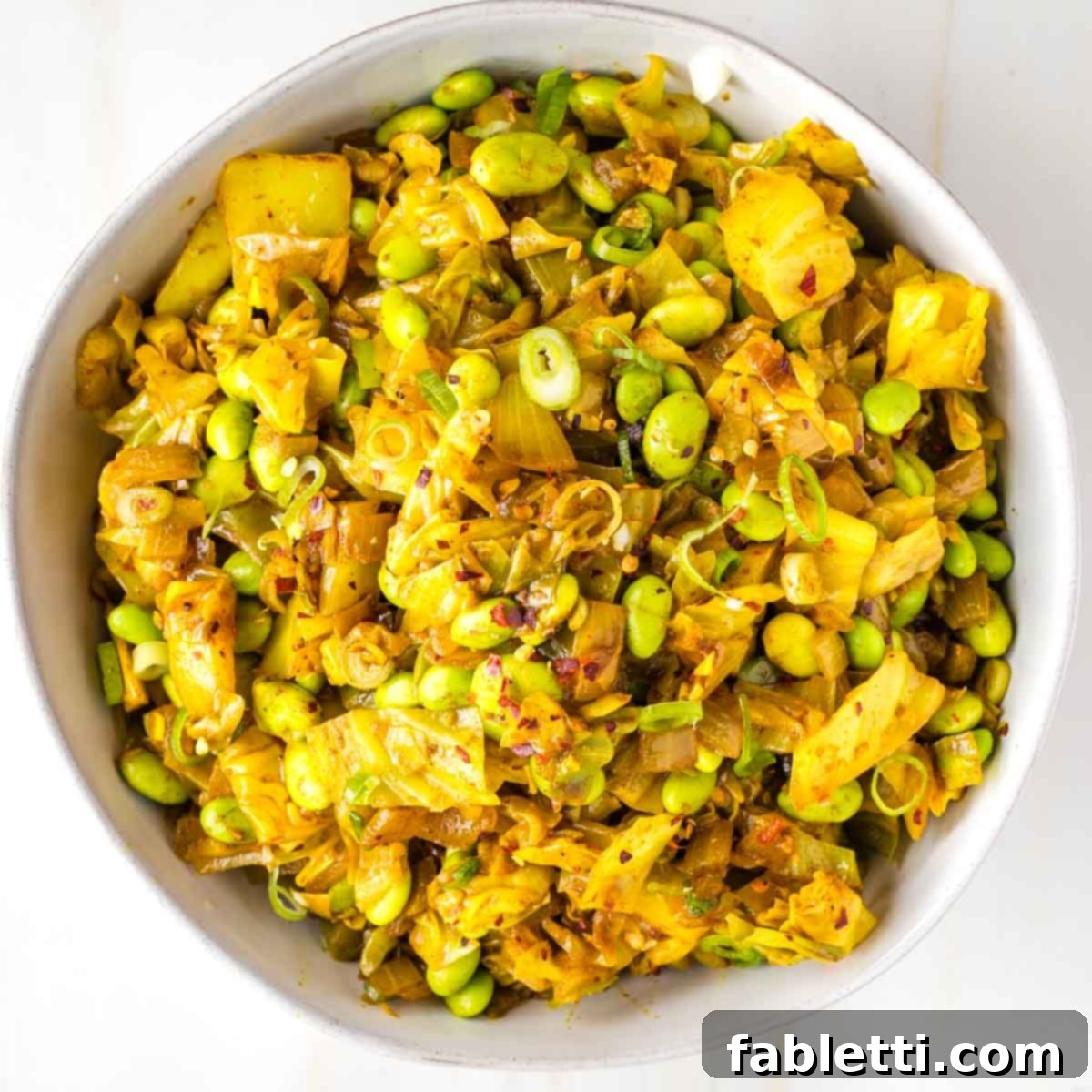
- Serving Temperature: This curry can be enjoyed warm, straight from the stove, or even at room temperature, especially on a warmer day.
- Storage: Store any leftover Cabbage Curry in an airtight container in the refrigerator for up to 5 days. It’s fantastic for packed lunches!
- Reheating: Reheat leftovers gently over medium heat on the stovetop until warmed through. You can add a tablespoon or two of water or broth if it seems a little dry. I’ve personally enjoyed the leftovers cold, and they were surprisingly delicious, taking on a fantastic marinated flavor!
- Freezing: I generally don’t recommend freezing this dish. The high water content of cabbage means its texture changes significantly when frozen and thawed, often becoming soggy. For best results, enjoy it fresh or refrigerated.
- Serving Suggestions:
- As a Main: Serve it generously over fluffy basmati rice, brown rice, quinoa, or with a side of warm naan bread or roti for a complete meal.
- As a Side: It pairs beautifully with grilled tofu, tempeh, or your favorite plant-based protein. It also complements lentil dhal, other curries, or even a simple grilled vegetable platter.
- With a Twist: Transform it into a power bowl by adding roasted sweet potatoes, a dollop of hummus, and a sprinkle of toasted nuts.
- Lunchbox Hero: This curry makes for an excellent make-ahead lunch option. It’s flavorful and satisfying, even when eaten cold.
Discover More Quick & Easy Side Dish Recipes
If you loved the simplicity and flavor of this Cabbage Curry, you’ll definitely want to explore these other fast and fantastic side dish recipes from my kitchen:
- Sautéed Broccolini and Garlic
- Cauliflower Rice with Asparagus
- Lemony Green Bean Salad
- Baby Bok Choy with Ginger and Scallions
Your feedback means the world! If you tried this recipe and loved it, please consider leaving a five-star rating and a comment below. It’s one of the best ways to support your favorite food bloggers. Don’t forget to share your beautiful creations on Instagram by tagging me @dkhealthcoach and using the hashtag #debraklein. I can’t wait to see your culinary adventures!
📖 15-Minute Stovetop Curried Cabbage Recipe
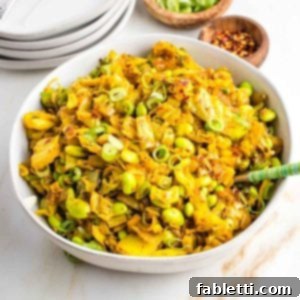
15-Minute Stovetop Curried Cabbage
Debra Klein
Pin Recipe
5
10
15
Main Course, Side Dish
American, Indian
4
98 kcal
Equipment
- 12″ Cast Iron Skillet
- Wooden Spoon
Ingredients
Adjust Servings:
- ½ head green cabbage, roughly chopped
- 1 yellow onion, diced
- 3 cloves garlic, minced
- 1 tablespoon curry powder
- ½ tsp coarse sea salt
- ½ tsp black pepper
- ¼ cup water (plus 1-4 tablespoons more, as needed)
- 1 cup frozen, shelled edamame
- 2 scallions, thinly sliced (for garnish)
Instructions
- Prep: Roughly chop the green cabbage, dice the yellow onion, mince the garlic, and thinly slice the scallions for garnish. Having all your ingredients ready makes the cooking process smooth and quick.
- Sauté Onions: Heat a heavy skillet (a 12-inch cast iron skillet is ideal) over medium heat. Add your diced onion and sauté it in either a tablespoon of olive oil, a splash of vegetable broth, or a tablespoon or two of water. Cook for about 2 minutes, or until the onions begin to soften and become translucent.
- Bloom Spices: Stir in the minced garlic, curry powder, ½ teaspoon of coarse sea salt, and ½ teaspoon of black pepper. Continue cooking, stirring constantly, for about 30 seconds. This short “blooming” time helps release the full aroma and flavor of the spices. If the pan becomes too dry and ingredients start to stick, add 1-2 tablespoons of water immediately.
- Add Cabbage: Add the roughly chopped cabbage to the skillet. Stir it thoroughly, ensuring that every piece of cabbage is well-coated with the fragrant spice mixture. The pan will look very full initially, but the cabbage will wilt and reduce significantly as it cooks.
- Simmer and Steam: Pour in ¼ cup of water. Stir everything once more, then cover the skillet tightly with a lid. Allow the cabbage to steam and simmer for about 5 minutes. This helps to tenderize the cabbage while infusing it with all the delicious curry flavors.
- Introduce Edamame: Remove the lid from the skillet. Stir in the frozen shelled edamame beans. Continue to cook for approximately 2 more minutes, stirring occasionally, until the edamame is heated through and the cabbage has reached your desired level of tenderness. If at any point the pan seems dry, add up to 2 additional tablespoons of water.
- Final Seasoning and Serve: Taste the curried cabbage and adjust the seasoning as needed. If you desire more heat, sprinkle in a pinch of crushed red pepper flakes. Garnish generously with the thinly sliced scallions before serving warm. Enjoy this quick, flavorful, and satisfying dish!
Notes
Nutrition
Calories:
98
kcal
Carbohydrates:
16
g
Protein:
6
g
Fat:
2
g
Saturated Fat:
0.2
g
Polyunsaturated Fat:
0.1
g
Monounsaturated Fat:
1
g
Sodium:
315
mg
Potassium:
443
mg
Fiber:
6
g
Sugar:
6
g
Vitamin A:
188
IU
Vitamin C:
45
mg
Calcium:
95
mg
Iron:
2
mg
Note
The nutrition calculations were done using online tools and are estimates. To obtain the most accurate representation of the nutritional information in any given recipe, you should calculate the nutritional information with the actual ingredients you used. You are ultimately responsible for ensuring that any nutritional information is accurate, complete, and useful.
